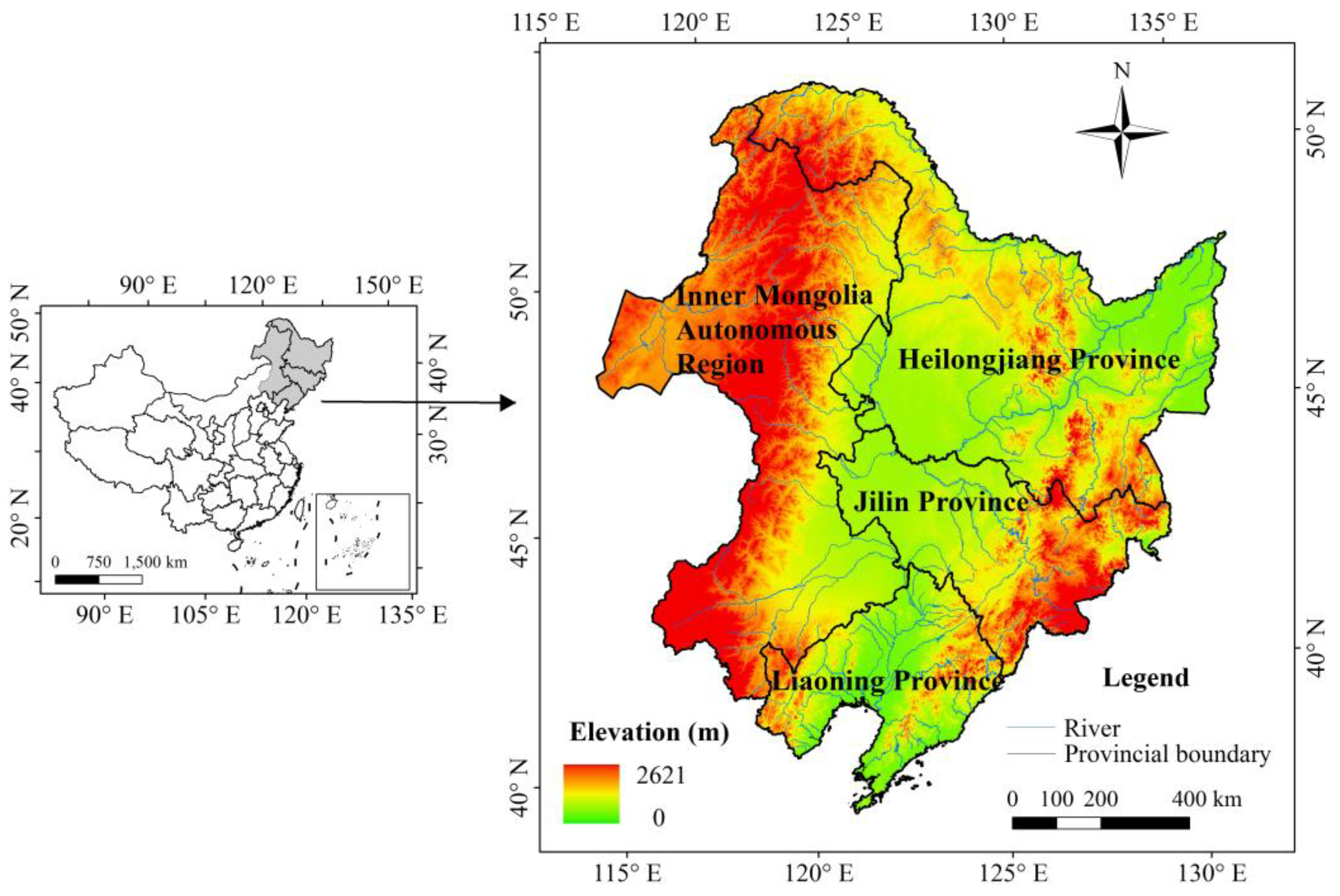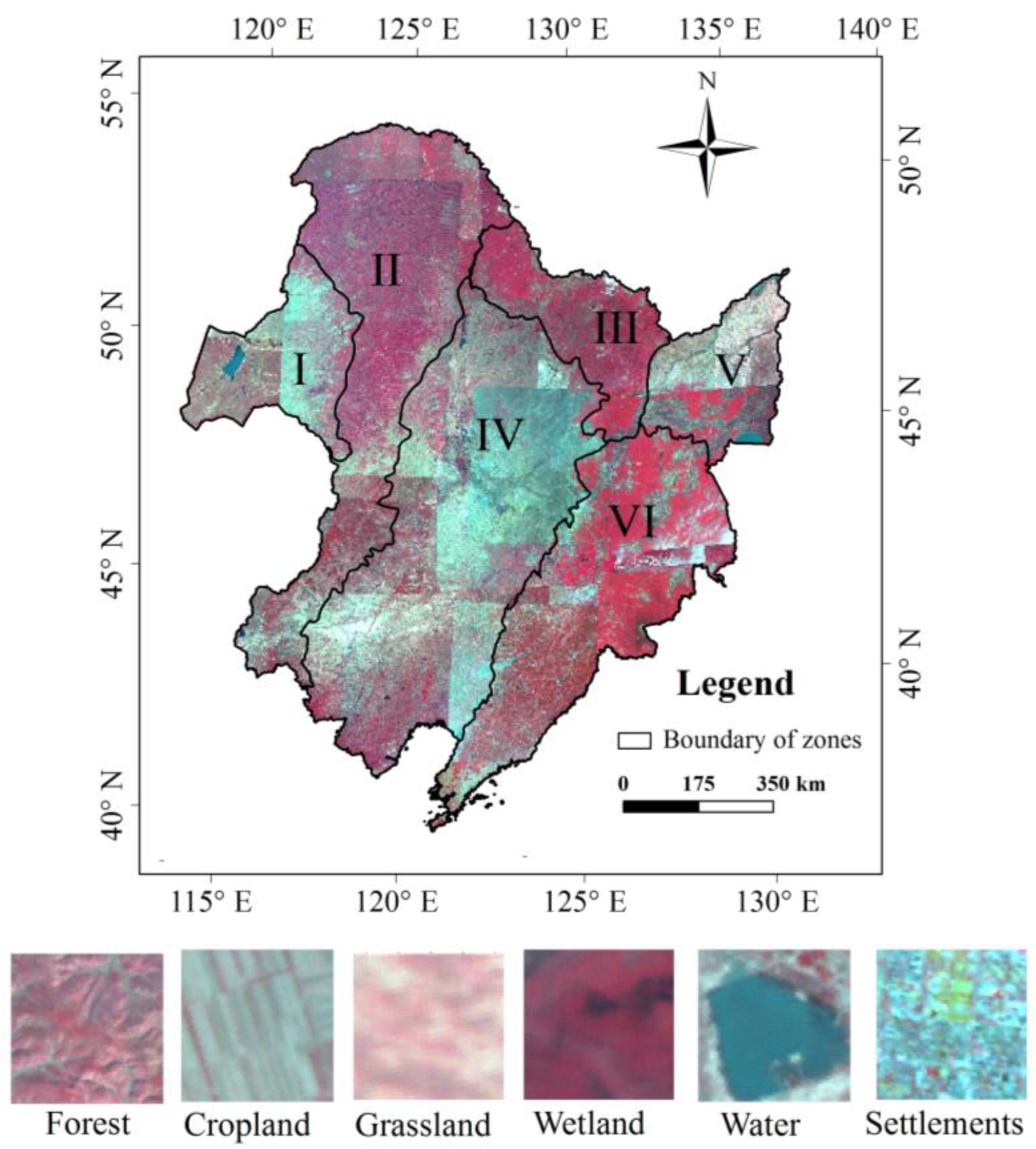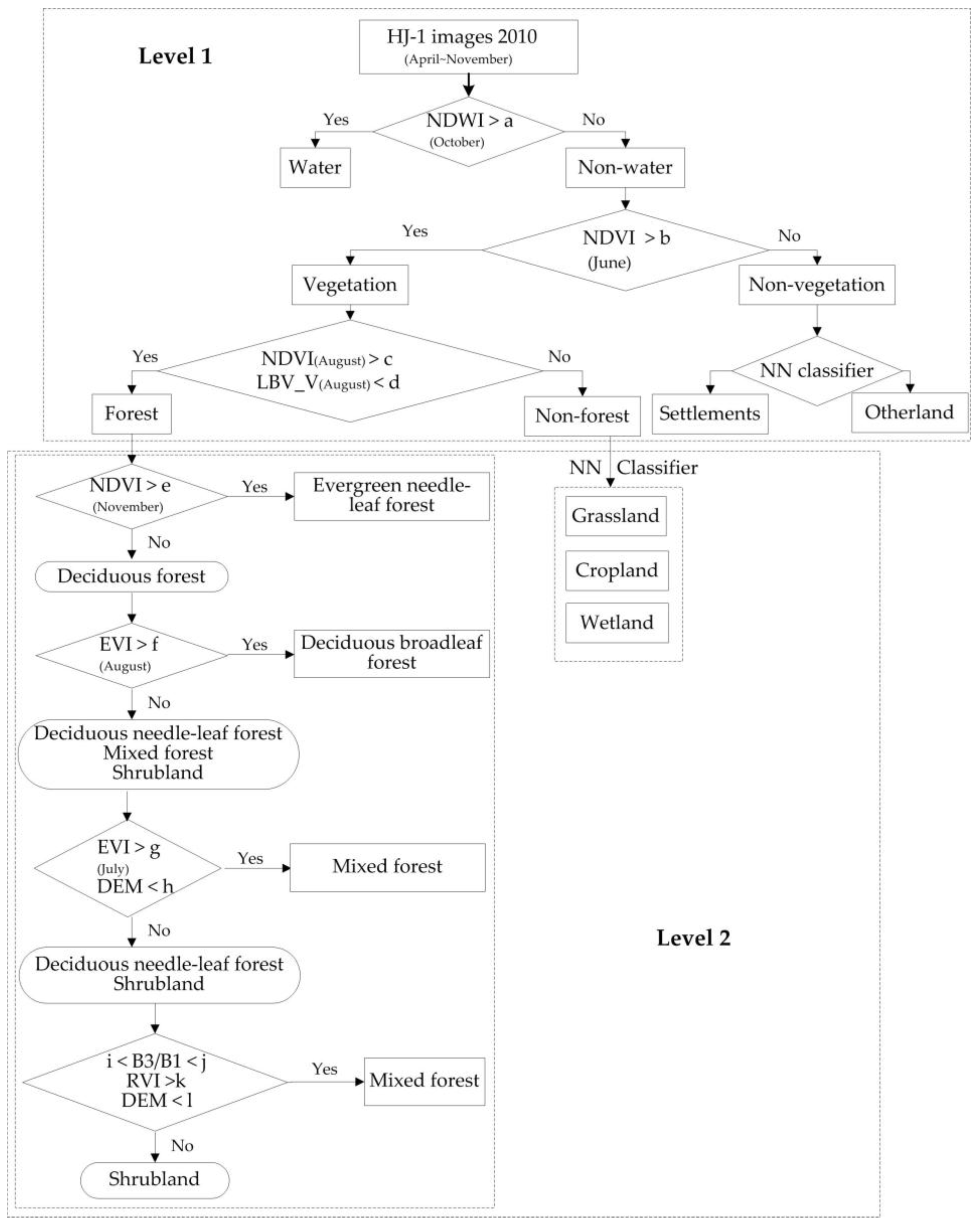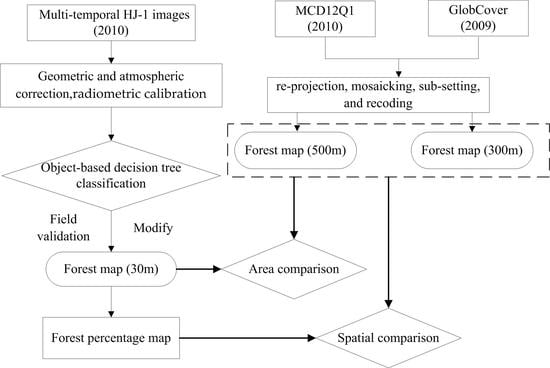Mapping Forest Cover in Northeast China from Chinese HJ-1 Satellite Data Using an Object-Based Algorithm
Abstract
1. Introduction
2. Materials and Methods
2.1. Study Area
2.2. HJ-1 Satellite Images and Preprocessing
2.3. Classification System
2.4. Ground Truth Data for Training and Validation
2.5. Forest Classification Method
2.5.1. Spatial Partitioning
2.5.2. Multi-Resolution Segmentation
2.5.3. Object-Based Decision Tree Algorithm
2.6. Accuracy Assessment of the HJ-1-Based Forest Map in 2010
2.7. Comparison between HJ-1-Based Forest Map and Other Land Cover Products
3. Analyses and Results
3.1. Forest Distribution of Northeast China Derived from HJ-1 Images
3.2. Area Comparison between HJ-1-Based Forest Map and Other Global Products
3.3. Spatial Differences between the HJ-1-Based Forest Map, GlobCover, and MCD12Q1
4. Discussion
4.1. Forest Classification in Northeast China
4.2. Advantages of Forest Classification Using HJ-1 Images and Object-Based Method
4.3. Uncertainties of Forest Classification in Northeast China
5. Conclusions
Author Contributions
Funding
Acknowledgements
Conflicts of Interest
References
- Food and Agriculture Organization (FAO). Main Report: Global Forest Resources Assessment; FAO: Rome, Italy, 2011. [Google Scholar]
- Liu, R.G.; Liang, S.L.; Liu, J.Y.; Zhuang, D.F. Continuous tree distribution in China: A comparison of two estimates from Moderate-resolution imaging spectroradiometer and Landsat data. J. Geophys. Res. 2006, 111, D08101. [Google Scholar] [CrossRef]
- Bonan, G.B. Forests and climate change: Forcings, feedbacks, and the climate benefits of forests. Science 2008, 320, 1444–1449. [Google Scholar] [CrossRef] [PubMed]
- Malmer, A.; Murdiyarso, D.; Bruijnzeel, L.A.; llstedt, U. Carbon sequestration in tropical forests and water: A critical look at the basis for commonly used generalizations. Glob. Chang. Biol. 2010, 16, 599–604. [Google Scholar] [CrossRef]
- Xiao, X.M.; Boles, S.; Liu, J.Y.; Zhuang, D.F.; Liu, M.L. Characterization of forest types in Northeastern China, using multi-temporal SPOT-4 VEGETATION sensor data. Remote Sens. Environ. 2002, 82, 335–348. [Google Scholar] [CrossRef]
- Yu, D.; Zhou, L.; Zhou, W.; Ding, H.; Wang, Q.; Wang, Y.; Dai, L. Forest management in Northeast China: History, problems, and challenges. Environ. Manag. 2011, 48, 1122–1135. [Google Scholar] [CrossRef] [PubMed]
- Zheng, Y.; Xiao, X.; Guo, Z.; Howard, T. A county-level analysis of the spatial distribution of forest resources in China. J. For. Plant. 2001, 7, 69–78. [Google Scholar]
- Xia, B.; Hu, J.; Song, X. Analysis of land-use change in Taoerhe catchment during last 15 years. J. Soil Water Conserv. 2004, 18, 122–125. [Google Scholar]
- Wang, S.; Zhao, Y.; Yin, X.; Yu, L.; Xu, F. Land use and landscape pattern changes in Nenjiang River Basin during 1988–2002. Front. Earth Sci. 2010, 4, 33–41. [Google Scholar] [CrossRef]
- Huang, W. Forest condition change, tenure reform, and government-funded eco-environmental programs in Northeast China. Forest Policy Econ 2019, 98, 67–74. [Google Scholar] [CrossRef]
- Wang, T.; Wang, X.; Guo, Q.; Sun, L.; Gui, G. Forest landscape diversity changes in Heilongjiang Province. Chin. Biodivers. 2003, 12, 396–402. [Google Scholar]
- Zhao, B.Z.; Jia, W.W.; Li, F.R. Effect evaluation of Natural Forest Protection Project for forestry enterprises in Daxing’anling of Inner Mongolia. J. Northest For. Univ. Chin. Ed. 2006, 34, 84–86. [Google Scholar]
- Shen, Y.; Liao, X.; Yin, R. Measuring the socioeconomic impacts of China’s Natural Forest Protection program. Environ. Dev. Econ. 2006, 11, 769–788. [Google Scholar] [CrossRef]
- Peng, H.; Cheng, G.; Xu, Z.; Yin, Y.; Xu, W. Social, economic, and ecological impacts of the “Grain for Green” project in China: A preliminary case in Zhangye, Northwest China. J. Environ. Manag. 2007, 85, 774–784. [Google Scholar] [CrossRef] [PubMed]
- Nandy, S.; Kushwaha, S.P.S.; Dadhwal, V.K. Forest degradation assessment in the upper catchment of the river Tons using remote sensing and GIS. Ecol. Ind. 2011, 11, 509–513. [Google Scholar] [CrossRef]
- Dong, J.; Xiao, X.; Sheldon, S.; Biradar, C.; Duong, N.D.; Hazarika, M. A comparison of forest cover maps in Mainland Southeast Asia from multiple sources: PALSAR, MERIS, MODIS and FRA. Remote Sens. Environ. 2012, 127, 60–73. [Google Scholar] [CrossRef]
- Liu, J.; Huang, D.; Ling, Y. Vegetation integrated classification and mapping using remote sensing and GIS techniques in Northeast China. J. Remote Sens. 1998, 4, 285–291. [Google Scholar]
- Jin, C. Study of Land Cover Classification and Change Detection in Northeast China Using MODIS Time-Series Datasets. Ph.D. Thesis, University of Chinese Academy of Sciences, Beijing, China, 2009. [Google Scholar]
- Yan, E.; Wang, G.; Lin, H.; Xia, C.; Sun, H. Phenology-based classification of vegetation cover types in Northeast China using MODIS NDVI and EVI time series. Int. J. Remote Sens. 2015, 36, 489–512. [Google Scholar] [CrossRef]
- Kuenzer, C.; Leinenkugel, P.; Vollmuth, M.; Dech, S. Comparing global land-cover products-implications for geoscience applications: An investigation for the trans-boundary Mekong Basin. Int. J. Remote Sens. 2014, 35, 2752–2779. [Google Scholar] [CrossRef]
- Fritz, S.; See, L.; McCallum, I.; Schill, C.; Obersteiner, M.; Van der Velde, M.; Achard, F. Highlighting continued uncertainty in global land cover maps for the user community. Environ. Res. Lett. 2011, 6, 044005. [Google Scholar] [CrossRef]
- Hansen, M.C.; Stehman, S.V.; Potapov, P.V. Quantification of global gross forest cover loss. Proc. Natl. Acad. Sci. USA 2010, 107, 8650–8655. [Google Scholar] [CrossRef]
- Shao, G.; Zhao, G.; Zhao, S.; Shugart, H.H.; Wang, S.; Schaller, J. Forest cover types derived from Landsat Thematic Mapper Imagery for Changbai Mountain area of China. Can. J. For. Res. 1996, 26, 206–216. [Google Scholar] [CrossRef]
- Xu, X.L.; Liu, J.Y.; Zhuang, D.F.; Zhang, S.W. Analysis on spatial-temporal characteristics and driving factors of woodland change in the northeastern China based on 3S technology. Sci. Geogr. Sin. 2004, 24, 60–66. [Google Scholar] [CrossRef]
- Deng, X.; Jiang, Q.O.; Zhan, J.; He, S.; Lin, Y. Simulation on the dynamics of forest area changes in Northeast China. J. Geogr. Sci. 2010, 20, 495–509. [Google Scholar] [CrossRef]
- Zhang, Q.; Ren, R.; Zhao, L. Forest spatial distribution and influencing factors in Northeast China. J. Northest For. Univ. Chin. Ed. 2013, 41, 25–28. [Google Scholar]
- Jia, K.; Wu, B.; Li, Q. Crop classification using HJ satellite multispectral data in the North China Plain. J. Appl. Remote Sens. 2013, 7, 073576. [Google Scholar] [CrossRef]
- Sun, C.; Liu, Y.; Zhao, S.; Zhou, M.; Yang, Y.; Li, F. Classification mapping and species identification of salt marshes based on a short-time interval NDVI time-series from HJ-1 optical imagery. Int. J. Appl. Earth Obs. 2016, 45, 27–41. [Google Scholar] [CrossRef]
- Wang, J.; Huang, J.; Gao, P.; Wei, C.; Mansaray, L.R. Dynamic mapping of rice growth parameters using HJ-1 CCD time series data. Remote Sens. 2016, 8, 931. [Google Scholar] [CrossRef]
- Zhong, B.; Ma, P.; Nie, A.; Yang, A.; Yao, Y.; Lü, W.; Zhang, H.; Liu, Q.H. Land cover mapping using time series HJ-1/CCD data. Sci. China Earth Sci. 2014, 57, 1790–1799. [Google Scholar] [CrossRef]
- Hansen, M.; Defries, R.; Townshend, J.; Sohlberg, R. Global land cover classification at 1 km spatial resolution using a classification tree approach. Int. J. Remote Sens. 2000, 21, 1331–1364. [Google Scholar] [CrossRef]
- Churches, C.; Wampler, P.; Sun, W.; Smith, A. Evaluation of forest cover estimates for Haiti using supervised classification of Landsat data. Int. J. Appl. Earth Obs. 2014, 30, 203–216. [Google Scholar] [CrossRef]
- Mitchell, M.; Wilson, R.; Twedt, D.; Mini, A.; James, J. Object-based forest classification to facilitate landscape-scale conservation in the mississippi alluvial valley. Remote Sens. Appl. Soc. Environ. 2016, 4, 55–60. [Google Scholar] [CrossRef]
- Xu, E.; Zhang, H.; Li, M. Object-based mapping of KARST rocky desertification using a support vector machine. Land Degrad. Dev. 2012, 26, 158–167. [Google Scholar] [CrossRef]
- Cufi, X.; Munoz, X.; Friexenet, J.; Marti, J. A review of image segmentation techniques integrating region and boundary information. Adv. Imaging Electron. Phys. 2002, 120, 1–39. [Google Scholar]
- Yu, Q.; Gong, P.; Chinton, N.; Biging, G.; Kelly, M.; Schirokauer, D. Object based detailed vegetation classification with airborne high spatial resolution remote sensing imagery. Photogramm. Eng. Remote Sens. 2006, 72, 799–811. [Google Scholar] [CrossRef]
- Johnsson, K. Segment-based land-use classification from SPOT satellite data. Photogramm. Eng. Remote Sens. 1994, 60, 47–53. [Google Scholar]
- Yan, G.; Mas, J.; Maathuis, B.; Xiangmin, Z.; Van, D. Comparison of pixel-based and object-oriented image classification approaches—A case study in a coal fire area, Wuda, Inner Mongolia, China. Int. J. Remote Sens. 2006, 27, 4039–4055. [Google Scholar] [CrossRef]
- Myint, S.; Gober, P.; Brazel, A.; Grossman-Clarke, S.; Weng, Q. Per-pixel vs. object-based classification of urban land cover extraction using high spatial resolution imagery. Remote Sens. Environ. 2011, 115, 1145–1161. [Google Scholar] [CrossRef]
- Whiteside, T.; Boggs, G.; Maier, S. Comparing object-based and pixel-based classifications for mapping savannas. Int. J. Appl. Earth Obs. 2011, 13, 884–893. [Google Scholar] [CrossRef]
- Pham, L.T.H.; Brabyn, L.; Ashraf, S. Combining Quickbird, LiDAR, and GIS topography indices to identify a single native tree species in a complex landscape using an object-based classification approach. Int. J. Appl. Earth Obs. 2016, 50, 187–197. [Google Scholar] [CrossRef]
- Kamal, M.; Phinn, S. Hyperspectral data for mangrove species mapping: A comparison of pixel-based and object-based approach. Remote Sens. 2011, 3, 2222–2242. [Google Scholar] [CrossRef]
- Ke, Y.H.; Quackenbush, L.J.; Im, J.H. Synergistic use of Quickbird multispectral imagery and LiDAR data for object-based forest species classification. Remote Sens. Environ. 2010, 114, 1141–1154. [Google Scholar] [CrossRef]
- Tan, K.; Piao, S.; Peng, C.; Fang, J. Satellite-based estimation of biomass carbon stocks for northeast China’s forests between 1982 and 1999. For. Ecol. Manag. 2007, 240, 114–121. [Google Scholar] [CrossRef]
- Sun, Z.P.; Shen, W.M.; Wei, B.; Liu, X.M.; Su, W.; Zhang, C.; Yang, J.Y. Object-oriented land cover classification using HJ-1 remote sensing imagery. Sci. China Earth Sci. 2010, 53, 34–44. [Google Scholar] [CrossRef]
- ITT Visual Information Solutions. ENVI User’s Guide: Version 4.8; ITT Visual Information Solutions: Boulder, CO, USA, 2010. [Google Scholar]
- Gao, B.C.; Kaufman, Y.J. The MODIS Near-IR Water Vapor Algorithm. Available online: https://modis-atmosphere.gsfc.nasa.gov/sites/default/files/ModAtmo/atbd_mod03_0.pdf (accessed on 4 February 2016).
- Potapov, P.; Hansen, M.C.; Stehman, S.V.; Loveland, T.R.; Pittman, K. Combining MODIS and Landsat imagery to estimate and map boreal forest cover loss. Remote Sens. Environ. 2008, 112, 3708–3719. [Google Scholar] [CrossRef]
- Definiens, A.G. Definiens Professional 8.6 User Guide; Definiens, A.G.: Munchen, Germany, 2011. [Google Scholar]
- Milne, R.; Jallow, B.P.; Arrouays, C.; Drichi, I.; Beets, P.; Harun, I.B.; Lin, E. Basis for Consistent Representation of Land Areas; Intergovernmental Panel on Climate Change, IPCC: Kanagawa, Japan, 2003. [Google Scholar]
- Environmental Systems Research Institute (ESRI). ArcGIS 9.3; Environmental Systems Research Institute: Redlands, CA, USA, 2008. [Google Scholar]
- Ren, G.; Zhu, A.; Wang, W.; Xiao, W.; Huang, Y.; Li, G. A hierarchical approach coupled with coarse DEM information for improving the efficiency and accuracy of forest mapping over very rugged terrains. For. Ecol. Manag. 2009, 258, 26–34. [Google Scholar] [CrossRef]
- Editorial Board of Vegetation Map of China, Chinese Academy of Sciences (EBVMC). Vegetation Regionalization Map of China; Science Press: Beijing, China, 2001. [Google Scholar]
- Fu, B.; Liu, G.; Chen, L.D.; Ma, K.; Li, J. Scheme of ecological regionalization in China. Acta Ecol. Sin. 2001, 21, 1–6. [Google Scholar]
- Baatz, M.; Schäpe, A. Multiresolution Segmentation: An Optimization Approach for High Quality Multi-Scale Image Segmentation; Angewandte Geographische Informations verarbeitung XII Wichmann: Heidelberg, Germany, 2000; Volume 58, pp. 12–23. [Google Scholar]
- Zeng, Z.Y.; Pan, X.Z. Study on soil Gleization in subtropic region of China using LBV transformed Landsat images. Pedosphere 1997, 7, 219–224. [Google Scholar]
- Zhou, Y.L. Vegetation Geography of Northeast China; Science Press: Beijing, China, 1997. [Google Scholar]
- Rodrigues, S.; Souza-Filho, P. Use of Multi-Sensor Data to Identify and Map Tropical Coastal Wetlands in the Amazon of Northern Brazil. Wetlands 2011, 31, 11–23. [Google Scholar] [CrossRef]
- Olofsson, P.; Foody, G.M.; Stehman, S.V.; Woodcock, C.E. Making better use of accuracy data in land change studies: Estimating accuracy and area and quantifying uncertainty using stratified estimation. Remote Sens. Environ. 2013, 129, 122–131. [Google Scholar] [CrossRef]
- Bicheron, P.; Defourny, P.; Brockmann, C.; Schouten, L.; Vancutsem, C.; Huc, M.; Ranera, F. GlobCover 2008 Products Description and Validation Report. Available online: http://postel.mediasfrance.org/en/DOWNLOAD/Documents/#globcover (accessed on 2 January 2015).
- Friedl, M.A.; Sulla-Menashe, D.; Tan, B.; Schneider, A.; Ramankutty, N.; Sibley, A.; Huang, X. MODIS Collection 5 global land cover: Algorithm refinements and characterization of new datasets. Remote Sens. Environ. 2010, 114, 168–182. [Google Scholar] [CrossRef]
- State of the Environment Report. 2010. Available online: http://www.360doc.com/content/12/0606/10/1302411_216337729 (accessed on 2 June 2015).
- Wang, Z.; Mao, D.; Li, L.; Jia, M.; Dong, Z.; Miao, Z.; Song, C. Quantifying changes in multiple ecosystem services during 1992–2012 in the Sanjiang Plain of China. Sci. Total Environ. 2015, 514, 119–130. [Google Scholar] [CrossRef]
- Hansen, M.C.; Potapov, P.V.; Moore, R.; Hancher, M.; Turubanova, S.A.; Tyukavina, A.; Thau, D.; Stehman, S.V.; Goetz, S.J.; Loveland, T.R.; et al. High-resolution global maps of 21st-century forest cover change. Science 2013, 342, 850–853. [Google Scholar] [CrossRef]
- Reiche, J.; Lucas, R.; Mitchell, A.L.; Verbesselt, J.; Hoekman, D.H.; Haarpaintner, J.; Kellndorfer, J.M.; Rosenqvist, A.; Lehmann, E.A.; Woodcock, C.E. Combining satellite data for better tropical forest monitoring. Nat. Clim. Chang. 2016, 6, 120–122. [Google Scholar] [CrossRef]
- Pirotti, F. Analysis of full-waveform LiDAR data for forestry applications: A review of investigations and methods. iForest-Biogeosci. For. 2011, 4, 100–106. [Google Scholar] [CrossRef]
- Ouyang, Z.; Fan, P.; Chen, J. Urban Built-up Areas in Transitional Economies of Southeast Asia: Spatial Extent and Dynamics. Remote Sens. 2016, 8, 819. [Google Scholar] [CrossRef]
- Bontemps, S.; Defourny, P.; Bogaert, E.V.; Arino, O.; Kalogirou, V.; Perez, J.R. GLOBCOVER 2009-Products Description and Validation Report. Available online: http://www.webcitation.org/6ewikBY3L (accessed on 2 December 2015).
- Strahler, A.; Muchoney, D.; Borak, J.; Friedl, M.; Gopal, S.; Lambin, E.; Moodyf, A. MODIS Land Cover Product Algorithm Theoretical Basis Document (ATBD) Version 5.0; Boston University: Boston, MA, USA, 1999. [Google Scholar]












| Weight | Levels | |
|---|---|---|
| Level 1 | Level 2 | |
| Scale (Units: pixels/meters) | 30/900 | 10/300 |
| Color | 0.7 | 0.9 |
| Shape | 0.3 | 0.1 |
| Smooth | 0.4 | 0.4 |
| Compact | 0.6 | 0.6 |
| Product Characteristics | GlobCover (2009) | MODIS Land Cover Type (MCD12Q1) | This Study (2010) |
|---|---|---|---|
| Sensor | MERIS | MODIS | HJ-1 CCD |
| Time of Data collection | Jan.–Dec. 2009 | 2010 | 2010 |
| Classification scheme | UN LCCS (22 classes) | IGBP (17 classes) | IPCC modified (12 classes) |
| Spatial resolution | 300 m | 500 m | 30 m |
| Forest Category from GlobCover (2009) | Forest Category from MCD12Q1 (2009) | Forest Category in This Study (2010) |
|---|---|---|
| Closed to open (>15%) broadleaved evergreen or semi-deciduous forest (>5 m) | Evergreen needleleaf forest | Evergreen needleleaf forest |
| Closed (>40%) broadleave deciduous forest (>5 m) | Evergreen broadleaf forest | Evergreen broadleaf forest |
| Open (15–40%) broadleaved deciduous forest/woodland (>5 m) | Deciduous needleleaf forest | Deciduous needleleaf forest |
| Closed (>40%) needleleaved evergreen forest (>5 m) | Deciduous broadleaf forest | Deciduous broadleaf forest |
| Open (15–40%) needleleaved deciduous or evergreen forest (>5 m) | Mixed forest | Mixed forest |
| Closed to open (>15%) mixed broadleaved and needleleaved forest (>5 m) | Open shrubland | Shrubland |
| Mosaic forest or shrubland (50–70%)/grassland (20–50%) | Closed shrubland | |
| Closed to open shrubland | ||
| Closed to open (>15%) broadleaved forest regularly flooded (semi-permanently or temperately)—Fresh or brackish water |
| Data | GT Samples | WI | UA | PA | OA | ||
|---|---|---|---|---|---|---|---|
| Forest | Non-Forest | ||||||
| HJ-1 CCD | forest | 1169 | 142 | 0.40 | 0.89 ± 0.02 | 0.87 ± 0.005 | 0.91 ± 0.01 |
| non-forest | 359 | 2303 | 0.60 | 0.94 ± 0.01 | 0.92 ± 0.005 | ||
| MCD12Q1 | forest | 520 | 127 | 0.34 | 0.80 ± 0.03 | 0.58 ± 0.007 | 0.71 ± 0.01 |
| non-forest | 1008 | 2318 | 0.66 | 0.70 ± 0.02 | 0.87 ± 0.007 | ||
| GlobCover | forest | 555 | 275 | 0.36 | 0.67 ± 0.03 | 0.56 ± 0.008 | 0.69 ± 0.02 |
| non-forest | 973 | 2170 | 0.64 | 0.70 ± 0.02 | 0.79 ± 0.008 | ||
| Class | GT Samples | WI | UA | PA | ||||
|---|---|---|---|---|---|---|---|---|
| ENF | DNF | DBF | MF | SRF | ||||
| ENF | 84 | 5 | 12 | 3 | 1 | 0.03 | 0.80 ± 0.03 | 0.76 ± 0.005 |
| DNF | 8 | 100 | 10 | 6 | 4 | 0.20 | 0.78 ± 0.04 | 0.75 ± 0.005 |
| DBF | 12 | 10 | 213 | 10 | 8 | 0.68 | 0.84 ± 0.02 | 0.84 ± 0.004 |
| MF | 5 | 13 | 16 | 82 | 6 | 0.07 | 0.70 ± 0.02 | 0.69 ± 0.008 |
| SRF | 1 | 5 | 3 | 17 | 31 | 0.02 | 0.54 ± 0.03 | 0.62 ± 0.007 |
| Heilongjiang | Jilin | Liaoning | Inner Mongolia | Total | |
|---|---|---|---|---|---|
| Evergreen needleleaf forest | 4277 | 4000 | 3911 | 2532 | 14,720 |
| Deciduous needleleaf forest | 46,731 | 2358 | 1854 | 47,226 | 98,169 |
| Deciduous broadleaf forest | 126,400 | 67,198 | 49,135 | 102,180 | 344,913 |
| Mixed forest | 20,116 | 9769 | 698 | 2781 | 33,364 |
| Shrubland | 946 | 1593 | 5508 | 3882 | 11,929 |
| Total HJ-1-based forest area | 198,470 | 84,918 | 61,106 | 158,601 | 503,095 |
| Total MCD12Q1 forest area | 187,474 | 33,258 | 74,735 | 129,800 | 425,267 |
| Total GlobCover forest area | 221,999 | 51,052 | 32,477 | 144,328 | 449,856 |
| National statistics of forest area (NSF) | 205,300 1 | 82,780 1 | 56,990 1 | 152,987 [45] | 498,057 |
© 2018 by the authors. Licensee MDPI, Basel, Switzerland. This article is an open access article distributed under the terms and conditions of the Creative Commons Attribution (CC BY) license (http://creativecommons.org/licenses/by/4.0/).
Share and Cite
Ren, C.; Zhang, B.; Wang, Z.; Li, L.; Jia, M. Mapping Forest Cover in Northeast China from Chinese HJ-1 Satellite Data Using an Object-Based Algorithm. Sensors 2018, 18, 4452. https://doi.org/10.3390/s18124452
Ren C, Zhang B, Wang Z, Li L, Jia M. Mapping Forest Cover in Northeast China from Chinese HJ-1 Satellite Data Using an Object-Based Algorithm. Sensors. 2018; 18(12):4452. https://doi.org/10.3390/s18124452
Chicago/Turabian StyleRen, Chunying, Bai Zhang, Zongming Wang, Lin Li, and Mingming Jia. 2018. "Mapping Forest Cover in Northeast China from Chinese HJ-1 Satellite Data Using an Object-Based Algorithm" Sensors 18, no. 12: 4452. https://doi.org/10.3390/s18124452
APA StyleRen, C., Zhang, B., Wang, Z., Li, L., & Jia, M. (2018). Mapping Forest Cover in Northeast China from Chinese HJ-1 Satellite Data Using an Object-Based Algorithm. Sensors, 18(12), 4452. https://doi.org/10.3390/s18124452










